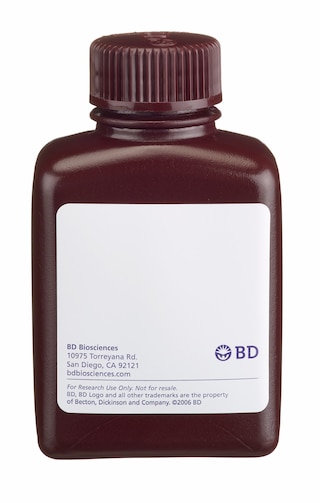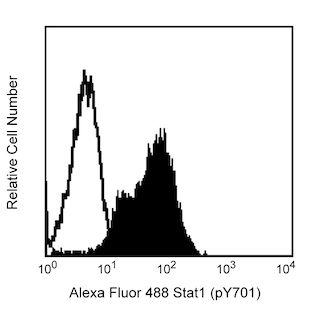Old Browser
This page has been recently translated and is available in French now.
Looks like you're visiting us from {countryName}.
Would you like to stay on the current country site or be switched to your country?


.png)

Flow cytometric analysis of PE anti-GATA4 in mouse testis, embryonal carcinoma F9 cells. The F9 cells were either treated with retinoic acid/dbcAMP (solid line) or untreated (dashed line). F9 cells were fixed (BD Cytofix™ Buffer Cat. No. 554655) for 10 minutes at 37ºC, permeabilized with BD Perm Buffer™ III (Cat. No. 558050) on ice for 30 minutes. The cells were stained with PE anti-GATA4 and incubated in the dark for 30 minutes at room temperature. Flow cytometry was performed on a BD FACSCanto™ II flow cytometry system. This antibody also works in BD Phosflow™ Perm Buffer I and II.
.png)

BD Pharmingen™ PE Mouse anti-GATA4
.png)
Regulatory Status Legend
Any use of products other than the permitted use without the express written authorization of Becton, Dickinson and Company is strictly prohibited.
Preparation And Storage
Product Notices
- This reagent has been pre-diluted for use at the recommended Volume per Test. We typically use 1 × 10^6 cells in a 100-µl experimental sample (a test).
- Please refer to www.bdbiosciences.com/us/s/resources for technical protocols.
- For fluorochrome spectra and suitable instrument settings, please refer to our Multicolor Flow Cytometry web page at www.bdbiosciences.com/colors.
- Caution: Sodium azide yields highly toxic hydrazoic acid under acidic conditions. Dilute azide compounds in running water before discarding to avoid accumulation of potentially explosive deposits in plumbing.
- Source of all serum proteins is from USDA inspected abattoirs located in the United States.
Companion Products


The L97-56 monoclonal antibody reacts with GATA4 (GATA-binding protein 4), a member of the GATA family of zinc finger-containing transcription factors that bind to the GATA nucleotide sequence. This ~50 kDa nuclear protein is expressed in mesodermal and definitive endodermal tissues such as the gastrointestinal tract, gonads, and heart. Genetic studies suggest that GATA4 regulates embryonic cardiac development in mice, and disruption of the GATA4 gene leads to defects in heart tube formation; in humans, GATA4 mutations are associated with atrial septal defects. In the adult heart, GATA4 regulates differentiated gene expression. The roles of GATA4 in endocrine and reproductive functions were recently reviewed.

Development References (2)
-
Oka T, Xu J, Molkentin JD. Re-employment of developmental transcription factors in adult heart disease. Semin Cell Dev Biol. 2007; 18(1):117-131. (Biology). View Reference
-
Viger RS, Guittot SM, Anttonen M, Wilson DB, Heikinheimo M. Role of the GATA family of transcription factors in endocrine development, function, and disease. Mol Endocrinol. 2008; 22(4):781-789. (Biology). View Reference
Please refer to Support Documents for Quality Certificates
Global - Refer to manufacturer's instructions for use and related User Manuals and Technical data sheets before using this products as described
Comparisons, where applicable, are made against older BD Technology, manual methods or are general performance claims. Comparisons are not made against non-BD technologies, unless otherwise noted.
For Research Use Only. Not for use in diagnostic or therapeutic procedures.
Report a Site Issue
This form is intended to help us improve our website experience. For other support, please visit our Contact Us page.